No Difference in Graft Survival Among Low Socioeconomic Kidney Allograft Recipients
1Transplant Nephrology, Loyola University Medical Center, Maywood, IL, 2Gift Of Hope Community Foundation, Itasca, IL, 3Transplant Surgery, Loyola University Medical Center, Maywood, IL
Meeting: 2022 American Transplant Congress
Abstract number: 1756
Keywords: Ethics, Graft survival, Kidney transplantation
Topic: Clinical Science » Kidney » 50 - Health Equity and Access
Session Information
Session Time: 7:00pm-8:00pm
 Presentation Time: 7:00pm-8:00pm
Presentation Time: 7:00pm-8:00pm
Location: Hynes Halls C & D
*Purpose: Low socioeconomic status remains a barrier in access and equity in kidney transplantation with limited data assessing post-transplant outcomes. Alternative options to transplantation include only renal replacement modalities with higher mortality and cost. Most disadvantaged are those who do not qualify for state or federal programs that cover organ transplantation. Private insurance remains prohibitively expensive for the same group. Few agencies have attempted to provide funding to assist those in need of health insurance to improve access and equity to organ transplantation. The purpose of this study was to assess the survival of kidney allografts in low socioeconomic recipients ineligible for traditional health insurance coverage compared to the overall recipient population at our center.
*Methods: Retrospective analysis of recipient and allograft data from 2015-2020. Low socioeconomic status was defined as household income below 200% of the poverty line and ineligibility for Medicare/Medicaid. Qualified state resident funding came from local not for profit organization, Illinois Transplant Fund (ITF), with interest in increasing access to organ transplantation and eliminating inequities for the uninsured.
*Results: Of 712 patients transplanted from 2015-2020, 75 qualified for source funding. Recipients were predominantly Hispanic in ethnic background (93.3% vs 34.2%) with cause of end-stage renal disease as hypertension (40.0% vs 21.7%) or other (40.0% vs 36.1%). Percentage of living donor transplants were similar between both cohorts (19.0% vs 24.0%). Statistically significant differences were noted in deceased donor hypertensive disease (12.0% vs 29.0%) and/or diabetes (19.0% vs 45.0%). Unadjusted analysis showed a hazard ratio of 0.72 (95% CI 0.22-2.30) for low socioeconomic recipients compared to the rest. When adjusted for recipient, donor and transplant factors the hazard ratio was 1.25 (95% CI 0.35-4.52). No difference was noted in kidney allograft survival between the two cohorts.
*Conclusions: Our results demonstrate no difference in kidney allograft survival between low socioeconomic recipients not qualifying for traditional insurance versus the remaining population. The data suggests that low socioeconomic status should not be a barrier to equity in access and kidney transplantation.
To cite this abstract in AMA style:
Desai A, Akkina S, Cmunt K, Jain D, Garcia-Roca R. No Difference in Graft Survival Among Low Socioeconomic Kidney Allograft Recipients [abstract]. Am J Transplant. 2022; 22 (suppl 3). https://atcmeetingabstracts.com/abstract/no-difference-in-graft-survival-among-low-socioeconomic-kidney-allograft-recipients/. Accessed December 18, 2025.« Back to 2022 American Transplant Congress

